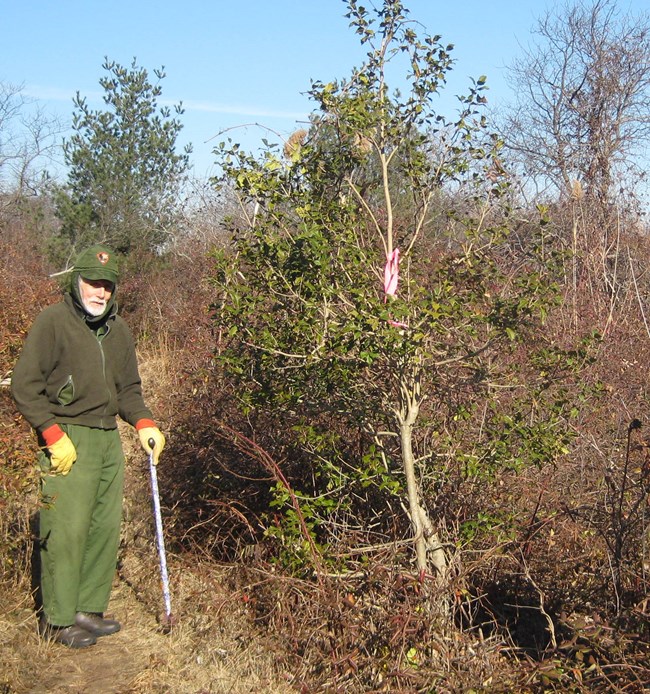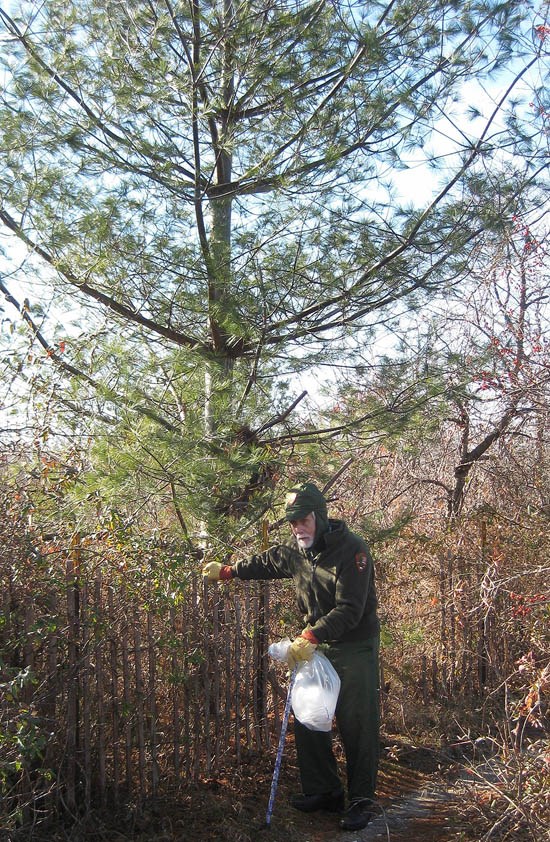
NPS Photo Why restore Crooke's Point? Invasive exotic plants are a major threat to the integrity of the plant communities that comprise our natural areas. These species have the ability to invade natural systems and proliferate, often dominating a community to the detriment and sometimes the exclusion of native species. Crooke's Point, a 28-acre peninsula located at Great Kills in the Staten Island Unit of Gateway National Recreation Area, is an example of severely degraded habitat that is currently dominated by several particularly aggressive invasive, exotic plant species. Approximately 85% of project area at Crooke's Point consists of invasive vines and without intervention, this degraded plant community will remain a poorly functioning habitat for many years. In addition, any remaining native vegetation from this plant community will be lost. Starting with a two-acre plot, the National Park Service (NPS), with the assistance and skills of the NYC Department of Parks & Recreation, will remove invasive, exotic vegetation such as Oriental bittersweet, Honeysuckle vine, Multiflora Rose and others, to replace with species native to local coastal barrier uplands and ultimately restore the area to a native habitat type. Over a period of several years, the park intends to restore all degraded habitat in a phased manner. 
NPS Photo Crooke's Point FAQ: What is the goal? The goal is to create coastal maritime forest and shrub-scrub plant communities consistent with similar to existing mid-Atlantic coastal environments. Why is this project important? Most local insects and wildlife are adapted to native vegetation and do not readily adapt to feed on the invasive, exotic vegetation currently overtaking the majority of Crooke's Point. It has been demonstrated and is supported by scientific evidence that native habitats increase biodiversity and provide more suitable food items and nesting options. Also, if left in its current state, the invasive vines would eventually kill the remaining plants and trees beneath eliminating valuable nesting habitat and food sources for wildlife. Why is this project a priority? The park has conducted a number of small vegetation restoration projects at Crooke's Point for decades. Manual hand pulling of invasives, regardless the size or skill of the laborers is only successful for small areas. Now, with the assistance of the New York City Department of Park and Recreation (NYCDPR), Gateway seeks to step up habitat improvement at Crooke's Point. With their help, the NPS will be able to tackle the project whereas the man-power and technology was not available before. Why bother restoring this area since it was originally composed of fill? Crooke's Point is an excellent location for resident and migratory populations but it doesn't fulfill its potential. We can help it fulfill its potential as a barrier island like the ones that used to exist in this area prior to urbanization. Great Kills Park was built by the New York City Department of Parks under the direction of Commissioner Robert Moses. Much of the land area of the park, including Crooke's Point, includes fill material dating back to the 1930s. The park was transferred to the NPS in 1972 as part of Gateway National Recreation Area. Despite its reinvention as a park through use of landfill, Crooke's Point is important resting and feeding habitat for migratory bird populations as well as migratory insects and is thus managed as a "natural area." It is NPS policy to remove invasive exotic plant species from areas of high natural resource value and to encourage native species. 
NPS Photo What native plants will be re-established? The plantings will include, but may not be limited to species such as: · White Pine Many of these species currently exist on Crooke's Point but in limited populations. Some have been locally extirpated due to the predominance of invasive exotics. Will the soil support the new plantings? Soil profiles have been described and sampled. Soil fertility (chemical) analyses have been performed. Native tree, shrub, and herbaceous species will be selected to match the existing soil fertility levels. Why are you using herbicides? Manual labor does not provide the progress needed to successfully restore large areas, especially when the areas contain a very high percentage of invasive species. Herbicides will be used to increase the chances that the invasives will not regenerate or return, thus providing a good start for the young native plants. Will these herbicides affect the water, wildlife or plants not intended for treatment? The judicious use of herbicides is currently a state of the art practice in the removal of invasive exotic plants and forest restoration. The NPS has very strict regulations regarding the appropriate use of herbicides within a National Park and are governed by NYSDEC and EPA regulations. These regulations will be followed. All herbicides used in this project and will be applied during suitable weather conditions (e.g. low wind speed) by certified and experienced applicators. What will happen to nesting birds and other wildlife including endangered species? The NPS is mandated to protect all endangered species and will always follow Federal Regulations regarding their treatment and protection. In an effort to minimize impacts to wildlife populations currently utilizing the Crooke's Point area, the restoration project will be phased over many years. This will allow resident and migratory wildlife to utilize adjacent areas (totaling 26-acres) as well as allow the NPS to continually apply best practices and successes to the following phases. In addition, work will be timed to occur when disruption to migratory or resident wildlife will be negligible and will not occur during nesting season. What will happen to the trails? Will I be able to use them? Existing trails will be maintained and used to access the restoration site to minimize impact to adjacent areas. To the greatest degree possible, trails will remain open to the public throughout the restoration. How will the project area be maintained? For the first few years, this area will be maintained by park staff and the generous contribution of volunteers. With the restoration being done correctly, the site should only require the occasional removal of weeds (invasive plants). Eventually, when the trees and new plantings are large enough, they will create a canopy cover that will shade out the majority of invasive plants and will become self-sustaining requiring little to no upkeep. Can you ensure success? Adaptive management techniques will ensure that the highest degree of success is achieved. Learning from successes as well as failures is part of the adaptive management process. The work is founded on the best available restoration science, including our site-specific data and comparisons to existing sustainable coastal maritime ecosystems that occur in the mid-Atlantic region. Post-planting monitoring is planned for at least 5 years. When will this project be done? The 2-acre project is scheduled to be planted during the Fall of 2013. Following the planting, the NPS and partners, will monitor the site closely to observe plant and animal species composition and changes in plant community structure to determine the level of success of the project and apply lessons learned to future restoration sites. What is the project timeline? Please click here for printable timeline (.pdf) April 2011 - January 2012: Early January 2012: Mid-January 2012: January 2012: January 25, 2012: February 2012: March - June 2012: July -August 2012: September - October 2012: November 2012 - February 2013: March - June 2013: July - August 2013: November 2013 - December 2015: |
Last updated: May 10, 2018
